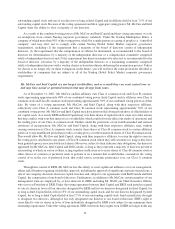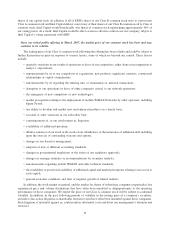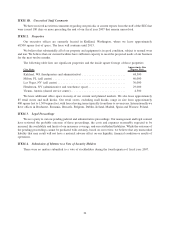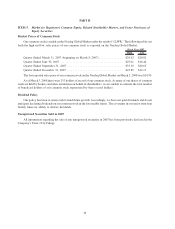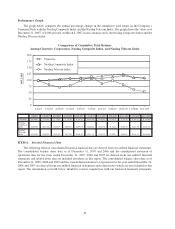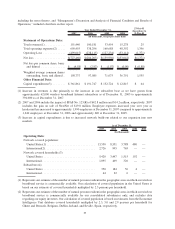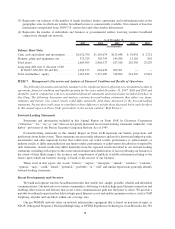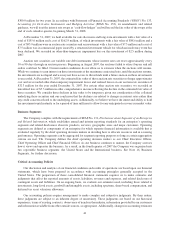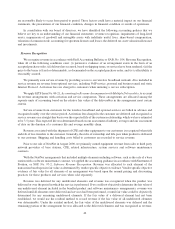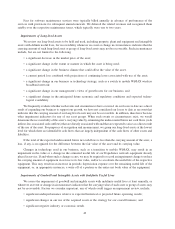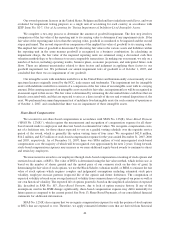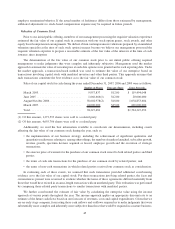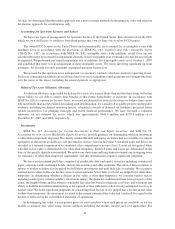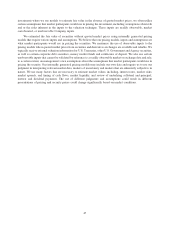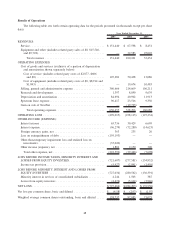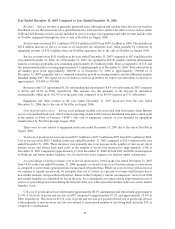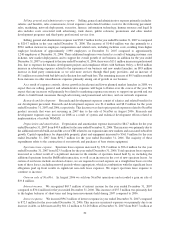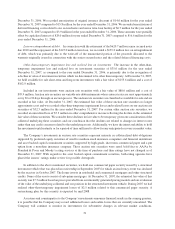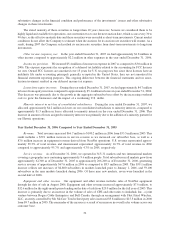Clearwire 2007 Annual Report Download - page 50
Download and view the complete annual report
Please find page 50 of the 2007 Clearwire annual report below. You can navigate through the pages in the report by either clicking on the pages listed below, or by using the keyword search tool below to find specific information within the annual report.are reasonably likely to occur from period to period. These factors could have a material impact on our financial
statements, the presentation of our financial condition, changes in financial condition or results of operations.
In consultation with our board of directors, we have identified the following accounting policies that we
believe are key to an understanding of our financial statements: revenue recognition; impairments of long-lived
assets; impairments of goodwill and intangible assets with indefinite useful lives; share-based compensation;
valuation of common stock; accounting for spectrum licenses and leases; the deferred tax asset valuation allowance
and investments.
Revenue Recognition
We recognize revenue in accordance with Staff Accounting Bulletin, or SAB, No. 104, Revenue Recognition,
when all of the following conditions exist: (i) persuasive evidence of an arrangement exists in the form of an
accepted purchase order; (ii) delivery has occurred, based on shipping terms, or services have been rendered; (iii) the
price to the buyer is fixed or determinable, as documented on the accepted purchase order; and (iv) collectibility is
reasonably assured.
We primarily earn service revenue by providing access to our wireless broadband network. Also included in
service revenue are revenue from optional services, including VoIP service, personal and business email and static
Internet Protocol. Activation fees are charged to customers when initiating a service subscription.
We apply EITF Issue No. 00-21, Accounting for Revenue Arrangements with Multiple Deliverables, to account
for revenue arrangements with activation and service components. These arrangements are allocated among the
separate units of accounting based on the relative fair values if the deliverables in the arrangement meet certain
criteria.
Service revenue from customers for the wireless broadband and optional services are billed in advance and
recognized ratably over the service period. Activation fees charged to the customer are deferred and recognized as
service revenue on a straight-line basis over the expected life of the customer relationship, which we have estimated
to be 3.5 years. This expected life was determined based on our assessment of industry averages and our assessment
of data on the duration of a customer life and average monthly churn.
Revenue associated with the shipment of CPE and other equipment to our customers is recognized when title
and risk of loss transfers to the customer. Generally, the risks of ownership and title pass when product is delivered
to our customer. Shipping and handling costs billed to customers are recorded to service revenue.
Prior to our sale of NextNet in August 2006, we primarily earned equipment revenue from sales to third party
network providers of base stations, CPE, related infrastructure, system services and software maintenance
contracts.
With the NextNet arrangements that included multiple elements including software, such as the sale of a base
station with a software maintenance contract, we applied the accounting guidance in accordance with Statement of
Position, or SOP, No. 97-2, Software Revenue Recognition. Revenue was allocated to each element of the
transaction based upon its fair value as determined by vendor specific objective evidence. Vendor specific objective
evidence of fair value for all elements of an arrangement was based upon the normal pricing and discounting
practices for those products and services when sold separately.
Revenue was deferred for any undelivered elements and revenue was recognized when the product was
delivered or over the period in which the service is performed. If we could not objectively determine the fair value of
any undelivered element included in the bundled product and software maintenance arrangements, revenue was
deferred until all elements were delivered and services had been performed, or until fair value could be objectively
determined for any remaining undelivered elements. If the fair value of a delivered element had not been
established, we would use the residual method to record revenue if the fair value of all undelivered elements
was determinable. Under the residual method, the fair value of the undelivered elements was deferred and the
remaining portion of the arrangement fee was allocated to the delivered elements and was recognized as revenue.
42


